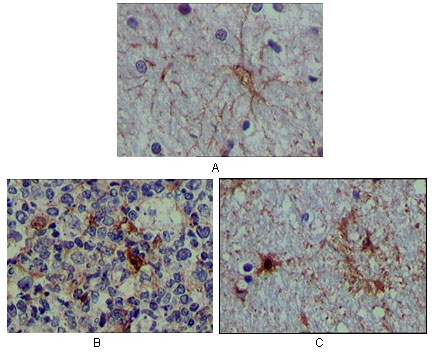S-100 α Monoclonal Antibody
- Catalog No.:YM0571
- Applications:WB;IHC;IF;ELISA
- Reactivity:Human
- Target:
- S-100 α
- Gene Name:
- S100A1
- Protein Name:
- Protein S100-A1
- Human Gene Id:
- 6271
- Human Swiss Prot No:
- P23297
- Mouse Swiss Prot No:
- P56565
- Immunogen:
- Purified recombinant fragment of S-100 α expressed in E. Coli.
- Specificity:
- S-100 α Monoclonal Antibody detects endogenous levels of S-100 α protein.
- Formulation:
- Liquid in PBS containing 50% glycerol, 0.5% BSA and 0.02% sodium azide.
- Source:
- Monoclonal, Mouse
- Dilution:
- WB 1:500 - 1:2000. IHC 1:200 - 1:1000. ELISA: 1:10000.. IF 1:50-200
- Purification:
- Affinity purification
- Storage Stability:
- -15°C to -25°C/1 year(Do not lower than -25°C)
- Other Name:
- S100A1;S100A;Protein S100-A1;S-100 protein alpha chain;S-100 protein subunit alpha;S100 calcium-binding protein A1
- Molecular Weight(Da):
- 11kD
- References:
- 1. Koenig A, Wojcieszyn J, Weeks BR, et al. Vet Pathol. 2001;38(4):427-35.
2. Hoyaux D, Decaestecker C, Heizmann CW, et al. Brain Res. 2000;867(1-2):280-8.
3. Pingerelli PL, Mizukami H, Wagner
- Background:
- S100 calcium binding protein A1(S100A1) Homo sapiens The protein encoded by this gene is a member of the S100 family of proteins containing 2 EF-hand calcium-binding motifs. S100 proteins are localized in the cytoplasm and/or nucleus of a wide range of cells, and involved in the regulation of a number of cellular processes such as cell cycle progression and differentiation. S100 genes include at least 13 members which are located as a cluster on chromosome 1q21. This protein may function in stimulation of Ca2+-induced Ca2+ release, inhibition of microtubule assembly, and inhibition of protein kinase C-mediated phosphorylation. Reduced expression of this protein has been implicated in cardiomyopathies. [provided by RefSeq, Jul 2008],
- Function:
- function:Weakly binds calcium but binds zinc very tightly-distinct binding sites with different affinities exist for both ions on each monomer. Physiological concentrations of potassium ion antagonize the binding of both divalent cations, especially affecting high-affinity calcium-binding sites.,similarity:Belongs to the S-100 family.,similarity:Contains 2 EF-hand domains.,subunit:Dimer of either two alpha chains, or two beta chains, or one alpha and one beta chain.,tissue specificity:Highly prevalent in heart. Also found in lesser quantities in skeletal muscle and brain.,
- Subcellular Location:
- Cytoplasm . Sarcoplasmic reticulum . Mitochondrion .
- Expression:
- Highly prevalent in heart (PubMed:12804600, PubMed:1384693). Also found in lesser quantities in skeletal muscle and brain (PubMed:1384693).
- June 19-2018
- WESTERN IMMUNOBLOTTING PROTOCOL
- June 19-2018
- IMMUNOHISTOCHEMISTRY-PARAFFIN PROTOCOL
- June 19-2018
- IMMUNOFLUORESCENCE PROTOCOL
- September 08-2020
- FLOW-CYTOMEYRT-PROTOCOL
- May 20-2022
- Cell-Based ELISA│解您多样本WB检测之困扰
- July 13-2018
- CELL-BASED-ELISA-PROTOCOL-FOR-ACETYL-PROTEIN
- July 13-2018
- CELL-BASED-ELISA-PROTOCOL-FOR-PHOSPHO-PROTEIN
- July 13-2018
- Antibody-FAQs
- Products Images

- Western Blot analysis using S-100 α Monoclonal Antibody against truncated S-100 α recombinant protein.

- Immunohistochemistry analysis of paraffin-embedded human brain tissue (A), lymphoid follicles tissue (B) and interbrain tissue (C), showing cytoplasmic localization with DAB staining using S-100 α Monoclonal Antibody.

